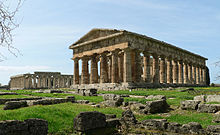
Back بايستوم Arabic بيستوم ARZ Пестум Byelorussian Пестум Bulgarian Paestum Catalan Пестум CE Paestum (lungsod) CEB Paestum Czech Paestum Danish Paestum German
Ποσειδωνία | |
 Paestum contains three of the best-preserved ancient Greek temples in the world, including the two Hera Temples shown above. | |
| Location | Paestum, Province of Salerno, Campania, Italy |
|---|---|
| Region | Magna Graecia |
| Coordinates | 40°25′20″N 15°0′19″E / 40.42222°N 15.00528°E |
| Type | Settlement |
| History | |
| Builder | Colonists from Sybaris and/or Troezen |
| Founded | Around 600 BC; 2625 years ago |
| Periods | Archaic Greece to Middle Ages |
| Site notes | |
| Management | Soprintendenza per i Beni Archeologici di Salerno, Avellino, Benevento e Caserta |
| Website | www |
| Official name | Cilento and Vallo di Diano National Park with the Archeological Sites of Paestum and Velia, and the Certosa di Padula |
| Type | Cultural |
| Criteria | iii, iv |
| Designated | 1998 (22nd session) |
| Reference no. | 842 |
| Region | Europe and North America |
Paestum (/ˈpɛstəm/ PEST-əm,[1] US also /ˈpiːstəm/ PEE-stəm,[2][3] Latin: [ˈpae̯stũː]) was a major ancient Greek city on the coast of the Tyrrhenian Sea, in Magna Graecia. The ruins of Paestum are famous for their three ancient Greek temples in the Doric order dating from about 550 to 450 BC that are in an excellent state of preservation. The city walls and amphitheatre are largely intact, and the bottom of the walls of many other structures remain, as well as paved roads. The site is open to the public, and there is a modern national museum within it, which also contains the finds from the associated Greek site of Foce del Sele.
Paestum was established around 600 BC by settlers from Sybaris, a Greek colony in southern Italy, under the name of Poseidonia (Ancient Greek: Ποσειδωνία). The city thrived as a Greek settlement for about two centuries, witnessing the development of democracy. In 400 BC, the Lucanians seized the city. Romans took over in 273 BC, renaming it Paestum and establishing a Latin colony. Later, its decline ensued from shifts in trade routes and the onset of flooding and marsh formation.[4] As Pesto or Paestum, the town became a bishopric (now only titular), but it was abandoned in the Early Middle Ages, and left undisturbed and largely forgotten until the eighteenth century.
Today the remains of the city are found in the modern frazione of Paestum, which is part of the comune of Capaccio Paestum in the Province of Salerno in the region of Campania, Italy. The modern settlement, directly to the south of the archaeological site, is a popular seaside resort with long sandy beaches. The Paestum railway station on the Naples-Salerno-Reggio Calabria railway line is directly to the east of the ancient city walls.
- ^ "Paestum". Collins English Dictionary. HarperCollins. Retrieved 18 August 2019.
- ^ "Paestum". The American Heritage Dictionary of the English Language (5th ed.). HarperCollins. Retrieved 18 August 2019.
- ^ "Paestum". Merriam-Webster.com Dictionary. Merriam-Webster. Retrieved 18 August 2019.
- ^ Gates, Charles (2011). Ancient cities: the archaeology of urban life in the ancient Near East and Egypt, Greece and Rome (2nd ed.). London: Routledge. pp. 311–312. ISBN 978-0-203-83057-4.
